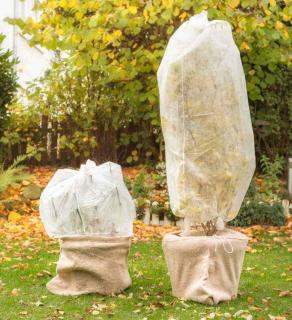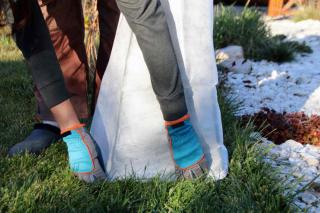

In the toolkit of a gardener attentive to the maintenance of their vegetable garden and ornamental garden, there is certainly a horticultural fleece. As soon as the first cold weather appears, this fleece allows for the protection of the most sensitive plants. However, horticultural fleece can have other uses.
To learn more:
At first glance, horticultural fleece resembles fabric due to its lightness and flexibility. However, it is made of non-woven polypropylene, which is most often presented in rolls. This white fleece is permeable to air and water. Consequently, it allows plants to breathe and withstand inclement weather right down to the core of the plants.
There are different types of horticultural fleece available in various weights, which means thicknesses. The higher the weight, the more effective the thermal protection:
For example, a 30g/m² fleece can increase the soil or substrate temperature in a pot by 35 to 39°F (2 to 4° C). However, it does not protect certain very frost-sensitive plants (citrus, exotic plants…) in any way, which should ideally be brought indoors, such as in a conservatory or winter garden.
For further information:
 Logically, the primary advantage of Winter Plant Covers lies in protecting the least hardy plants. These plants (oleanders, palms, escallonias, olive trees in pot…) can nevertheless spend the winter outdoors, cultivated in pots or in open ground, without suffering from a lack of air or water. Indeed, thanks to its permeability, horticultural fleece allows plants to breathe. Similarly, rains continue to fulfill their role by keeping the substrate moist. Moreover, Winter Plant Covers does not plunge the plants into darkness.
Logically, the primary advantage of Winter Plant Covers lies in protecting the least hardy plants. These plants (oleanders, palms, escallonias, olive trees in pot…) can nevertheless spend the winter outdoors, cultivated in pots or in open ground, without suffering from a lack of air or water. Indeed, thanks to its permeability, horticultural fleece allows plants to breathe. Similarly, rains continue to fulfill their role by keeping the substrate moist. Moreover, Winter Plant Covers does not plunge the plants into darkness.
Winter Plant Covers can also transform into a forcing fleece when simply placed on seedlings in the vegetable garden in spring. Thus, the germination of seeds is accelerated and facilitated by the mildness provided by the horticultural fleece.
Incidentally, the finest horticultural fleeces can serve as nets against early insect attacks such as cutworms and whiteflies, or as protection against birds swooping down on seedlings.
By definition, Winter Plant Covers is placed during the winter! A winter that truly begins with the appearance of the first nighttime or early morning frosts. In some regions, these frosts often start as early as October, or even in September, and continue throughout the winter.
Winter Plant Covers is also placed at the beginning of spring when fruit trees (dwarf) and plants with early spring blooms (camellias, magnolias, exochordas…) can be damaged by late frosts in March, or even in April or May (until the famous “Ice Saints”).
Used as a forcing fleece, horticultural fleece is placed on spring and autumn seedlings.
 When placed on a plant, horticultural fleece should not touch it to avoid, among other things, condensation points that can let in cold. Therefore, leave a breathing space between the fleece and the plant. Just plant three or four stakes or supports and place the horticultural fleece over these supports to encircle the plant. Then, secure it with strings or clothespins.
When placed on a plant, horticultural fleece should not touch it to avoid, among other things, condensation points that can let in cold. Therefore, leave a breathing space between the fleece and the plant. Just plant three or four stakes or supports and place the horticultural fleece over these supports to encircle the plant. Then, secure it with strings or clothespins.